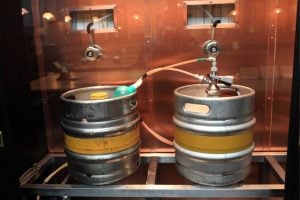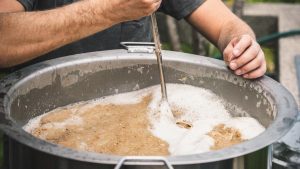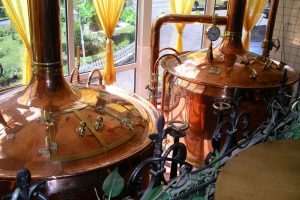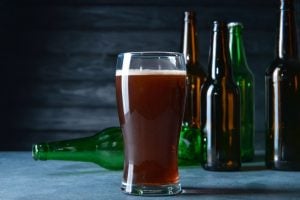How to Measure Alcohol Content Without Original Gravity: A Clear Guide

You can learn how to measure alcohol content without original gravity, but being accurate while doing this can be pretty challenging. A hydrometer is an effective tool for measuring ABV, and a refractometer can also come in handy.
It is possible for you to get very close estimations of alcohol content without original gravity. This article will show you how to do this effectively.
How to Measure Alcohol Content without Original Gravity: A Step-by-Step Guide
The following guide will help you check alcohol content without hydrometer more seamlessly.
The steps are divided into three sections:
-
Calibrate the Refractometer
Refractometers are cylindrical instruments that help measure sugar concentrations in water based on the refraction of light through the solution. So begin by shopping for your refractometers on homebrewing websites.
A digital refractometer is the best option if you desire a built-in light. On the other hand, an analog refractometer will require you to look at external light sources.
Step 1: Add Two to Three Drops of Water to the Refractometer and Shut Its Lid
The refractometer has a plastic cap on its end. Flip it open to show the glass underneath, and using a pipette, apply about two or three drops of distilled water to the top of the glass, ensuring that the water does not run off.
Then close the plastic lid to spread the water over the glass surface evenly. Distilled water is the best choice to avoid additives that may affect the readings.
Step 2: Hold the Refractometer at Eye Level To Point at a Light Source
Put the lens of the refractometer against one eye as the other end (with the glass) is pointed towards a light source. The light source can be a ceiling light or a lamp. When you look through the refractometer’s lens, you will notice a number scale ascending vertically.
It has a blue background section at the top and a white section at the bottom. A horizontal line splits both background sections – this is the hydrometer reading. Digital refractometers have built-in light in their bodies. In that case, there is no need for an external light source.
Step 3: Adjust the Calibration Screw for a Zero Reading on the Number Scale
If the horizontal line that crosses the number scale does not line up with the zero mark, check for the calibration screw present on top of the device. A screwdriver will help you rotate the screw clockwise or counter-clockwise to align it with the zero mark.
Some refractometers come with screwdrivers. You may cover the calibration screw with a plastic cap to prevent accidental rotation during refractometer use.
Step 4: Clean the Glass To Prevent Damage
Open the refractometer’s lip and dry off its glass with a lint-free microfiber towel. You might not be able to get all the water off with the towel, so you can allow it to air dry by leaving the lid open. Doing this will ensure the accuracy of results in future readings as moisture or water present on the refractometer could leak into it and affect readings.
-
Measure the Specific Gravity
The specific gravity indicates the amount of sugar in the beer. Estimating the amount of sugar converted to alcohol can help test alcohol content without hydrometer.
Step 1: Put Two or Three Drops of Unfermented Beer on the Refractometer

Put a small sample of the wort (or water and sugar starter liquid) into a pipette. Open the refractometer’s plastic lid and apply two to three drops to the glass. Ensure thin, even spreading out across the glass.
Step 2: Find the Brix Gravity Reading
While placing the lens of the refractometer against your eye, point the glass towards a light source. Adjust the focus by rotating the lens to allow you to see the scales more clearly.
Note where a horizontal line crosses the scale labeled “Brix %” and record your readings. It is best not to use the scale labeled “SG” because it may be hard to convert later.
Step 3: Take Another Brix Measurement Within the Second and Third Week of Fermentation
Let the wort or solution begin to ferment before taking the next reading to ensure accurate measurements. Repeat step (2) given above in this section, and record your readings. At this point, the Brix reading should be a bit lower than the initial reading.
Step 4: Divide Both Readings by 1.04 for Correction
Refractometers come with slight errors, so you need to divide your readings by 1.04 — the standard value for correction. Then write your initial and final Brix measurement values down, rounded to two decimal places. For example, an initial Brix reading of 14 will give you: 13/1.04 = 12.5. A final Brix reading of 9 will give you: 9/1.04 = 8.65.
-
Calculate the Alcohol by Volume
Carefully following the steps below allows you to proof alcohol without a hydrometer.
Step 1: Use the Correction Formula To Find the Final Specific Gravity
The formula is 1.0000 – (0.0044993 x IB) + (0.011774 x FB) + (0.00027581 x IB²) – (0.0012717 x FB²) – (0.0000072800 x IB³) + (0.000063293 x FB³).
- IB = initial Brix reading
- FB = final Brix reading
Input those values into the equation and simplify with a calculator to estimate the specific gravity. Finally, round your final answer to three decimal places.
Using the example in the previous section, we will have:
1.0000 – (0.0044993 x 12.5) + (0.011774 x 8.65) + (0.00027581 x (12.5²)) – (0.0012717 x (8.65²)) – (0.0000072800 x (12.5³)) + (0.000063293 x (8.65³)).
The final estimated specific gravity would be 1.020.
Step 2: Calculate the Specific Gravity of the Wort
The formula (IB / [258.6 – (IB / 258.2) x 227.1]) + 1 will help get the SG before fermentation begins. Input the corrected initial Brix measurement and estimate the value, rounding your answer to three decimal places.
From our example, we have (12.5 / [258.6 – (12.5 / 258.2) x 227.1]) + 1 to give a specific gravity of 1.050.
Step 3: Find the Alcohol Content
The final formula to use is (76.08 x [IG – FG] / [1.775 – IG]) x (FG / 0.794). This will help you in measuring the ABV of your beer after complete fermentation.
- IG = initial specific gravity
- FG = final specific gravity
Insert these values and calculate, rounding off your answer to three decimal places. Using our example, the IG was 1.050 while FG was 1.020.
So we have (76.08 x [1.050 – 1.020] / [1.775 – 1.050]) x (1.020 / 0.794). This will give us 2.550, which means the beer has 2.55 percent alcohol by volume.
How to Measure Alcohol Content Without Original Gravity: Are There More Modern Methods?
Pycnometers or density meters provide more modern and accurate measures of alcohol content. Highly advanced digital devices are now available. They are easier to use, displaying results within seconds. The automatic density meter easily measures a mixture’s density before accurately converting it into an alcohol concentration.
Important Terms To Note
Here are some terms to help you measure alcohol content like a pro.
These terms include the following:
- Alcohol By Volume (ABV): This is the percentage of alcohol in your beer.
- Fermentable Sugar: These are simple sugars that yeast can easily eat and convert to alcohol.
- Nonfermentable (or Unfermentable) Sugar: They are more complex sugars that are more difficult to eat by the yeast. They often add sweetness and body to your beers.
- Specific Gravity: This is the measure of the beer’s density compared to the density of water. The specific density of the beer can indicate the sugar level of the beer since sugar increases density. Readings taken at the start of fermentation and the end can help calculate the amount of sugar converted to alcohol.
- Original Gravity (OG): The density of the beer taken before the beginning of fermentation (the point with the highest sugar levels).
- Final Gravity (FG): This refers to the beer’s density measurement taken immediately after fermentation (the point with the lost sugar levels).
- Hitting the Gravity: The closest you get to the original gravity and final gravity readings using your homebrew.
Original gravity determination is essential for measuring the alcohol content of beers with hydrometers. However, a brewer can sometimes forget to take the original gravity measurement, especially if they are in a rush.
This will cause uncertainty in the OG, making it difficult to measure the ABV level. Hence, the need to learn how to measure ABV without hydrometer.
Check out our informative post about How Many Shots in a Pint
Conclusion
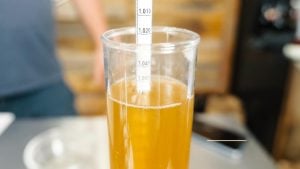
While hydrometers effectively measure alcohol content, the original gravity value may sometimes be unknown. This step-by-step guide gave you a detailed breakdown of how to measure alcohol content without original gravity.
Here is a summary of what we learned:
- Refractometers provide a means of measuring alcohol content without original gravity.
- The first step for estimating the alcohol volume is to calibrate the refractometer.
- Then, you need to measure the initial and final specific gravity using the Brix percentage readings on the refractometer.
- The specific gravity values will help you calculate the alcohol content of your drink using specific formulas.
- Other advanced devices are now available to measure alcohol content, such as an automatic density meter or pycnometer.
We hope this guide will come in handy whenever you want to measure alcohol content in your homebrew.

